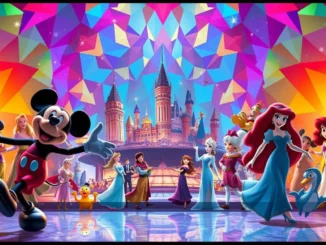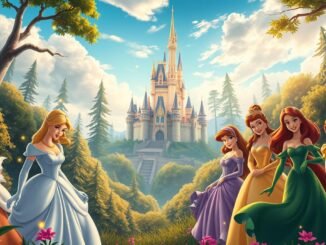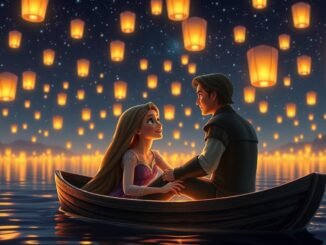
The world of beloved animation movies has been a cornerstone of entertainment for generations, offering a window into imaginative worlds, memorable characters, and timeless stories. These films not only entertain but also educate and inspire audiences of all ages.
The magic of animated classics lies in their ability to transport viewers to fantastical realms, evoke deep emotions, and create lasting memories. As we explore this enchanting world, we uncover the elements that make these stories so enduringly popular.
Key Takeaways
- Timeless stories continue to captivate audiences worldwide.
- Animated films educate and inspire viewers of all ages.
- Memorable characters and imaginative worlds are key to their enduring popularity.
- These classics evoke deep emotions and create lasting memories.
- The significance of beloved animation movies in the world of animation is undeniable.
The Golden Era of Animated Classics
The golden era of animation was a period of unprecedented artistic expression, marked by the release of films that continue to captivate audiences today. This era was defined by the pioneering work of studios like Walt Disney, who introduced innovations in storytelling and animation techniques.
Walt Disney’s Pioneering Contributions
Walt Disney was a trailblazer in the animation industry, introducing groundbreaking techniques that raised the bar for animators worldwide. His commitment to quality and storytelling helped establish Disney as a leader in the production of timeless animation films. Disney’s influence extended beyond his own studio, inspiring a generation of animators and filmmakers. For more on this period, see the golden age of American animation.
| Year | Film Title | Studio |
|---|---|---|
| 1937 | Snow White and the Seven Dwarfs | Walt Disney |
| 1940 | Pinocchio | Walt Disney |
| 1950 | Cinderella | Walt Disney |
The Impact of Fairy Tales on Animation
Fairy tales have been a cornerstone of animation, providing rich source material for stories that captivate both children and adults. The adaptation of these tales into best animated movies helped bring them to a wider audience, often with significant creative liberties that enhanced their appeal.
Memorable Characters from the Era
The golden era of animation was notable for its iconic characters, many of whom have become cultural icons. Characters like Mickey Mouse and Snow White continue to be recognized and beloved around the world, symbolizing the magic of this period in animation history.
Timeless Themes in Animated Classics
Timeless themes in animated classics are a significant factor in their lasting appeal and universal relatability. These themes, woven into the fabric of iconic animated features, continue to captivate audiences worldwide. Classic animated masterpieces often feature narratives that revolve around universal human experiences, making them accessible to a broad audience.
Friendship: A Universal Bond
One of the most prevalent themes in animated classics is the importance of friendship. Films like “The Lion King” and “Toy Story” showcase the power of friendship in overcoming challenges and achieving happiness. These stories highlight the value of loyalty, trust, and mutual support, resonating with viewers of all ages.
Triumph Over Adversity
Overcoming adversity is another timeless theme found in animated classics. Characters in these films often face significant obstacles, yet their perseverance and determination inspire audiences. For example, in “The Little Mermaid,” Ariel’s courage and resilience in the face of adversity serve as a powerful message about following one’s dreams.
The Power of Love and Sacrifice
Love and sacrifice are also central themes in many classic animated films. Stories like “Beauty and the Beast” and “Tangled” illustrate the transformative power of love and the sacrifices that come with it. These narratives underscore the depth of human emotion and the complexity of relationships, making the films more relatable and engaging.
In conclusion, the timeless themes present in animated classics are a key element in their enduring popularity. By exploring universal human experiences such as friendship, perseverance, and love, these films continue to captivate audiences and inspire new generations of viewers.
Modern Animated Classics to Watch
The world of animation has evolved significantly, giving rise to modern classics that captivate audiences worldwide. These films not only entertain but also often carry meaningful messages and showcase technological advancements in animation.
Pixar’s Impact on Modern Animation
Pixar has been a driving force in the resurgence of animation, producing films that are both critically acclaimed and commercially successful. Their innovative use of technology and storytelling has raised the bar for animated films.
Notable Pixar Films:
- Inside Out (2015) – A unique exploration of emotions and growing up.
- Coco (2017) – A vibrant celebration of Mexican culture and the importance of family.
- Toy Story 4 (2019) – The latest installment in the beloved Toy Story franchise, introducing new characters and adventures.
Studio Ghibli’s Unique Approach
Studio Ghibli is renowned for its distinctive animation style and poignant storytelling. Films produced by Ghibli have a timeless quality, captivating audiences with their beauty and depth.
Influential Ghibli Films:
- Spirited Away (2001) – A fantastical journey that won the Academy Award for Best Animated Feature.
- My Neighbor Totoro (1988) – A heartwarming tale of sisterhood and the magic of nature.
- Princess Mononoke (1997) – An epic fantasy set in medieval Japan, exploring themes of humanity and nature.
New Releases Worth Watching
The animation industry continues to evolve, with new releases pushing the boundaries of technology and storytelling. Recent films have introduced fresh narratives and characters, appealing to contemporary audiences.
| Film Title | Release Year | Notable Features |
|---|---|---|
| Encanto | 2021 | Vibrant animation, rich storytelling, and a celebration of Colombian culture. |
| Luca | 2021 | A coming-of-age story set in Italy, exploring themes of identity and friendship. |
| Raya and the Last Dragon | 2021 | A fantasy adventure inspired by Southeast Asian cultures, featuring stunning animation. |
These modern animated classics are must-watch films that showcase the diversity and richness of contemporary animation. Whether through Pixar’s innovative storytelling, Studio Ghibli’s unique style, or the latest releases from around the world, there’s something for everyone in the world of modern animated classics.
Iconic Soundtracks and Music in Animation
From ‘Snow White’ to ‘Frozen,’ music has been an integral part of Disney’s storytelling legacy. The enchanting world of animated classics is not just about visually stunning narratives but also about the iconic soundtracks that have become an indelible part of pop culture.
Disney’s Musical Legacy
Disney is renowned for its musical legacy, with songs like “When You Wish Upon a Star” from Pinocchio and “Let It Go” from Frozen becoming ingrained in our collective memory. These timeless classics have not only captivated audiences but have also set a high standard for musical storytelling in animation. For a deeper dive into Disney’s most beloved films, you can explore more at Disney Movies List.
The Role of Original Songs
Original songs in animated films play a crucial role in advancing the plot and deepening the emotional resonance of the story. They are not just add-ons but are intricately woven into the narrative fabric, making the films more engaging and memorable. For instance, songs like “Under the Sea” from The Little Mermaid not only entertain but also serve as pivotal moments in the story, enhancing the overall viewing experience.
Impact of Scores on Storytelling
The scores in animated classics further enrich the viewing experience, creating a memorable and impactful cinematic event. A well-crafted score can elevate the emotional impact of key scenes, making them more poignant and memorable. For example, the score in Beauty and the Beast perfectly complements the film’s narrative, adding depth and complexity to the story.
In conclusion, the iconic soundtracks and music in animation are crucial elements that enhance the narrative and emotional impact of animated films. Disney’s musical legacy, the role of original songs, and the impact of scores on storytelling all contribute to making animated classics timeless and unforgettable.
The Evolution of Animation Techniques
The animation industry has undergone significant transformations since its inception, evolving from traditional techniques to cutting-edge technology. This evolution has not only changed how animated films are made but has also impacted the quality and complexity of the stories being told.
Traditional Techniques and the Advent of CGI
The early days of animation were marked by hand-drawn techniques, where artists painstakingly created each frame by hand. This labor-intensive process resulted in some of the most iconic animated classics. The introduction of computer-generated imagery (CGI) marked a significant turning point, enabling the creation of more complex and visually stunning films.
The transition from traditional hand-drawn animation to CGI has been gradual, with many studios adopting a mix of both techniques to achieve the desired visual effect. For instance, films like Beauty and the Beast (1991) and The Lion King (1994) utilized traditional animation techniques, while movies like Toy Story (1995) pioneered the use of CGI.
Innovations in Animation Technology
The advancements in animation technology have been rapid, with innovations such as 3D modeling, motion capture, and advanced rendering techniques becoming more prevalent. These technologies have allowed animators to create more realistic characters and environments, enhancing the overall viewing experience.
Moreover, the development of sophisticated software has streamlined the animation process, enabling artists to work more efficiently and effectively. This has led to the production of high-quality animated films that captivate global audiences.
The Influence of Animation on Pop Culture
Animation’s influence extends far beyond the screen, with beloved characters and stories becoming integral to pop culture. Animated films inspire merchandise, theme park attractions, and even fashion, demonstrating their broad impact on society.
The iconic characters from animated classics, such as Mickey Mouse and Snow White, have become cultural icons, symbolizing nostalgia and joy for many. The influence of animation on pop culture is a testament to the power of storytelling and the enduring appeal of animated films.
Why Animated Classics Continue to Captivate Audiences
Animated classics have stood the test of time, remaining must-watch animated classics for generations. Their enduring appeal lies in a combination of factors that continue to enchant audiences worldwide.
Nostalgia’s Enduring Power
Nostalgia plays a significant role in the timeless appeal of these beloved animation movies. They evoke fond memories of childhood, creating a sentimental bond between the viewer and the film.
Promoting Values and Lessons
These films also promote valuable lessons and moral values, contributing to their lasting impact. The stories often revolve around universal themes such as friendship, perseverance, and self-discovery.
Global Reach and Influence
The global influence of animated classics is undeniable. They transcend cultural boundaries, appealing to diverse audiences around the world. Their impact is evident in the numerous adaptations, sequels, and inspirations they have spawned.
The magic of animated classics continues to captivate audiences, making them a treasured part of our shared cultural heritage.
FAQ
What makes an animated movie a classic?
Animated classics are timeless films that have captivated audiences for generations with their imaginative storytelling, memorable characters, and enduring themes. These beloved animation movies often feature a combination of engaging narratives, lovable characters, and significant cultural impact, making them stand the test of time.
Which animated classics are considered must-watch films?
Must-watch animated classics include iconic animated features like Disney’s “Snow White and the Seven Dwarfs,” “The Lion King,” and “Beauty and the Beast,” as well as Pixar’s “Toy Story” and Studio Ghibli’s “Spirited Away.” These timeless animation films have become an integral part of pop culture, continuing to enchant audiences worldwide.
How have animation techniques evolved over the years?
The evolution of animation techniques has transformed the industry, from traditional hand-drawn animation to the use of computer-generated imagery (CGI). Innovations in animation technology have enabled the creation of complex and visually stunning films, pushing the boundaries of storytelling and immersive experiences.
What role do soundtracks play in animated classics?
Soundtracks, particularly iconic soundtracks, play a significant role in enhancing the narrative and emotional impact of animated films. Original songs and scores in these films not only add to their charm but also advance the plot and deepen the emotional resonance of the story, creating a memorable cinematic event.
Why do animated classics continue to captivate modern audiences?
Animated classics continue to captivate modern audiences due to their timeless themes, such as friendship, perseverance, and the power of love. These universally relatable themes, combined with nostalgia and the cultural significance of these films, ensure their enduring appeal across generations.
What is the significance of nostalgia in animated classics?
Nostalgia plays a crucial role in the enduring popularity of animated classics, as they evoke fond memories of childhood for many viewers. This nostalgia factor contributes to their timeless appeal, making them a cherished part of many people’s cultural heritage.
How have animated classics influenced pop culture?
Animated classics have had a profound influence on pop culture, with characters and stories from these films becoming integral to our shared cultural landscape. They have inspired countless adaptations, sequels, and merchandise, cementing their place in the cultural consciousness.



